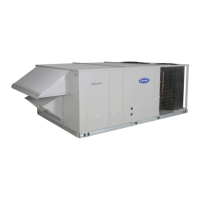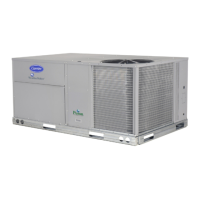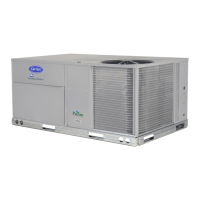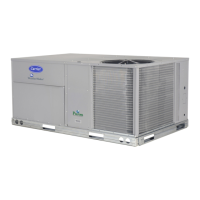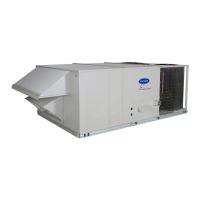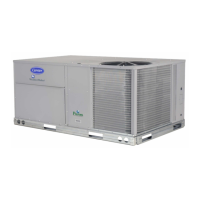10
8. Clean the outer surfaces with a stiff brush in the nor-
mal manner. Use a water hose or other suitable equip-
ment to flush down between the 2 coil sections to re-
move dirt and debris.
9. Secure the inner and outer coil rows together with a
field−supplied fastener.
10. Reposition the outer coil section and remove the coil
corner post from between the top panel and center
post. Reinstall the coil corner post and access panel.
11. Replace all screws.
EVAPORATOR COILS
The evaporator coil uses the traditional round-tube,
plate-fin (RTPF) technology. Tube and fin construction
consists of various optional materials and coatings (see
APPENDIX I. MODEL NUMBER NOMENCLATURE).
Coils are multiple-row. On two-compressor units, the
evaporator coil is a face split design, meaning the two
refrigerant circuits are independent in the coil. The bottom
portion of the coil will always be circuit A, with the top of
the coil being circuit B.
Coil Maintenance and Cleaning Recommendation
Routine cleaning of coil surfaces is essential to maintain
proper operation of the unit. Elimination of contamination
and removal of harmful residues will greatly increase the
life of the coil and extend the life of the unit. The
following maintenance and cleaning procedures are
recommended as part of the routine maintenance activities
to extend the life of the coil.
Removing Surface Loaded Fibers
Surface loaded fibers or dirt should be removed with a
vacuum cleaner. If a vacuum cleaner is not available, a
soft non- metallic bristle brush can be used. In either case,
the tool should be applied in the direction of the fins. Coil
surfaces can be easily damaged. Applying the tool across
the fin edges can cause the edges to be easily bent over,
damaging the coating of a protected coil.
NOTE: Use of a water stream, such as a garden hose,
against a surface-loaded coil will drive the fibers and dirt
into the coil. This will make cleaning efforts more
difficult. Surface-loaded fibers must be completely
removed prior to using a low-velocity clean water rinse. A
vacuum cleaner or a soft- bristled brush should be used to
remove surface-loaded fibers and dirt.
Periodic Clean Water Rinse
A periodic clean-water rinse is very beneficial for coils
that are used in coastal or industrial environments.
However, it is very important that the water rinse is made
with a very low-velocity water stream to avoid damage to
the fin edges. Monthly cleaning, as described below, is
recommended.
Routine Cleaning of Evaporator Coil Surfaces
Monthly cleaning with Totaline environmentally sound
coil cleaner is essential to extend the life of the coils. This
cleaner is available from Carrier Replacement Parts
Division (p/n: P902- 0301 for one-gallon (3.8L) container,
and p/n: P902- 0305 for a 5-gallon (18.9L) container). It is
recommended that all round tube coils be cleaned as
described below. Coil cleaning should be part of the unit’s
regularly scheduled maintenance procedures to ensure a
long life for the coil. Failure to clean the coils can result
in reduced durability in the environment. When cleaning
the coils, avoid use of the following:
coil brighteners
acid cleaning prior to painting
high pressure washers
poor quality water for cleaning
Totaline environmentally sound coil cleaner is a non-
flammable, hypo allergenic, non bacterial, USDA accept-
ed biodegradable agent that will not harm the coil or sur-
rounding components such as electrical wiring, painted
metal surfaces, or insulation. Use of non−recommended
coil cleaners is strongly discouraged since coil and unit
durability could be affected.
TotalineR Environmentally Sound Coil Cleaner
Application Equipment
2−1/2 gallon garden sprayer
Water rinse with low velocity spray nozzle
PERSONAL INJURY HAZARD
Failure to follow this WARNING can result in severe
personal injury and reduced unit performance.
High−velocity water from a pressure washer, garden
hose, or compressed air should never be used to clean
a coil. The force of the water or air jet will bend the
fin edges and increase airside pressure drop.
High−velocity water from a pressure washer can
cause severe injury upon contact with exposed body
tissue. Always direct the water stream away from the
body.
!
WARNING
Totaline Environmentally Sound Coil Cleaner
Application Instructions
1. Proper protection such as safety glasses, gloves and
protective clothing are recommended during mixing
and application.
EQUIPMENT HAZARD
Failure to follow this CAUTION can result in
corrosion and damage to the unit.
Harsh chemicals, household bleach or acid or basic
cleaners should not be used to clean outdoor or indoor
coils of any kind. These cleaners can be very difficult
to rinse out of the coil and can accelerate corrosion at
the fin/tube interface where dissimilar materials are in
contact. If there is dirt below the surface of the coil,
use the Totaline environmentally sound coil cleaner.
CAUTION

